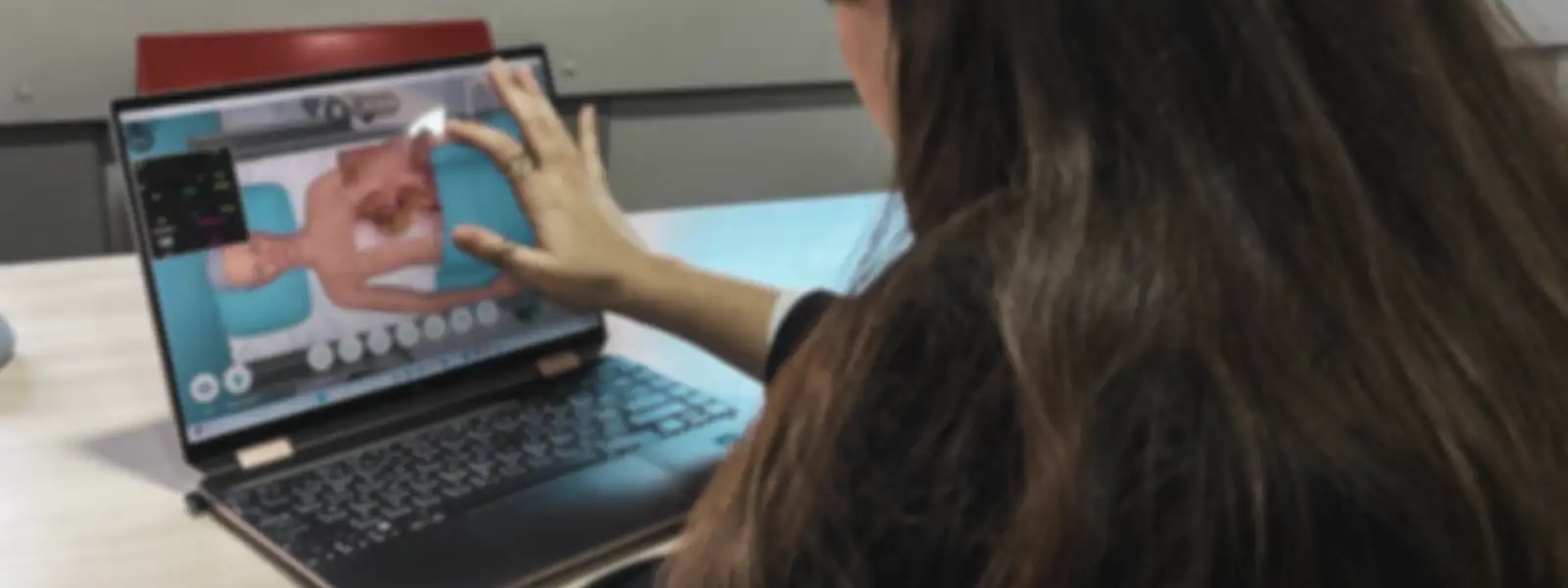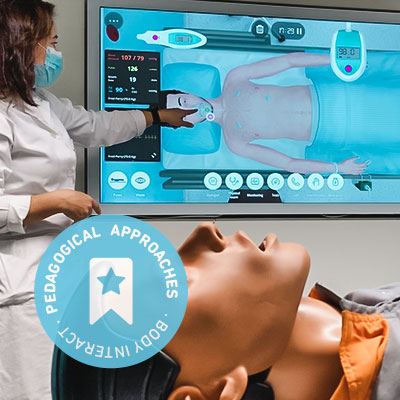Pedagogical Approaches with Body Interact | Clinical Reasoning Curricular Unit
Building on Prof. Leila Sales’s extensive experience integrating Body Interact into the nursing curriculum at the Portuguese Red Cross Health School in Lisbon, a groundbreaking idea emerged: creating a curricular unit dedicated to developing students’ clinical reasoning skills through simulation-based learning with Body Interact.
This innovative pedagogical approach seeks to enhance students’ decision-making skills in clinical practice and inspire other institutions to implement similar initiatives.
Clinical Reasoning Unit – Overview
📍 School: Portuguese Red Cross Health School, Lisbon
📌 Course Name: Pathology and Clinical Reasoning in Nursing
📅 Curriculum: 1st year, 2nd term – Nursing
⏳ Workload: 135 hours
👩🏫 Responsible Faculty: Prof. Leila Sales
🩺 Number of Clinical Cases: 20 Body Interact Virtual Patients

Learning Objectives of “Pathology and Clinical Reasoning in Nursing”
This practical, simulation-based curricular unit is designed to help students:
- Integrate critical-reflexive thinking in decision-making regarding interventions to be developed among adults and elderly persons/families with medical-surgical changes.
- Apply the nursing process when caring for adults and elderly persons/families with medical-surgical changes.
- Demonstrate evidence-based knowledge that enables a systematic evaluation of best practices for informed decision-making.
- Develop clinical reasoning skills by applying the nursing process in a simulated environment using Body Interact.
Prior Knowledge relevant to the unit
Essential and previously addressed in the curriculum are the Nursing Process, Anatomy, Fundamentals of Nursing, Principles of Pharmacology, Physiology, and Pathology.
Teaching Methodologies and Resources
This curricular unit is delivered through in-person classes, utilizing problem-based learning as the core teaching methodology. Body Interact Virtual Patients serve as the primary resource to achieve the learning objectives outlined earlier.
Activity Structure and Methodology
1. Group division
Based on research findings (1), Prof. Leila opted to divide the large student cohort into smaller groups of 15 students to enhance engagement and learning outcomes.
2. Briefing
At the start of each session, a Body Interact clinical case is presented and briefed.
3. Initial brainstorming
The professor initiates a discussion by posing broad questions to assess students’ understanding of the case.
[E.g.: Is there any doubt about what has been provided? Is there any particular information that you would like to highlight?].
4. Case resolution (two possible approaches):
4.A) Professor-Led Approach
The simulation is conducted collaboratively with the professor and students.
The case is paused at key moments to discuss and analyze critical decision points.
[E.g.: Given the available information, what should we assess first? Why is this the priority?]
4.B) Team-Based Approach
Students work together to determine the appropriate assessment, interview, and patient management steps.
They then solve the case independently, without direct intervention from the professor. Afterward, the professor conducts the debriefing with the students and highlights the critical decision points of the simulation.
5. Session Duration
While the Body Interact case itself is set to last around 20 minutes, the session extends to approximately 1 hour due to pausing, reflections, and guided questioning strategies.
6. Debriefing
Following the simulation, students engage in a structured reflection guided by the professor.
The discussion is supported by data collected from the software, allowing for an evidence-based review of decisions made.
The professor provides feedback aligned with the defined learning objectives.
7. Nursing Process Application
The group undergoes a nursing process for the VP case that has been simulated.
[Insider Tip: Prof. Leila Sales shared that sometimes two groups get together (a total of 30 students) with two professors simultaneously, fostering a more dynamic exchange of ideas and insights.]

Evaluation
The evaluation process is conducted using a Body Interact clinical scenario and is based on a grading system composed of two key dimensions:
- Performance data collected by the software
Objective metrics automatically generated by Body Interact during the simulation. - Nursing Competencies Beyond Software-Tracked Data
Additional competencies relevant to the learning objectives that are not directly mapped by the software. (e.g.: Nursing diagnosis, interventions, and evaluations, prioritization of actions during the simulation, and time management between interventions)
This dual approach ensures a comprehensive assessment of students’ clinical reasoning, decision-making, and nursing competencies
Benefits of using Body Interact in this curricular unit
Integrating Body Interact into this curricular unit offers a range of pedagogical and practical benefits, enriching students’ learning experiences and preparing them for real-world clinical scenarios.
- Development of Core Clinical Skills
– Strengthens clinical reasoning by encouraging students to analyze patient cases, synthesize information, and make informed decisions.
– Enhances decision-making under time-sensitive and evolving patient conditions.
– Reinforces prioritization skills, ensuring students can efficiently assess and manage critical patient needs.
– Deepens understanding and application of the nursing process in a structured and interactive environment. - Fostering Critical Thinking and Inquiry
– Encourages students to develop questioning skills, fostering a habit of inquiry and critical analysis.
– Promotes a reflective approach to learning, where students assess their reasoning and identify areas for improvement. - Enhanced Teamwork and Communication
– Strengthens collaborative problem-solving by enabling students to work in teams during case resolutions.
– Develops interprofessional communication skills, a crucial aspect of patient care and coordination in clinical settings. - Realistic, Risk-Free Learning Environment
– Provides exposure to diverse, complex patient cases in a controlled and safe setting.
– Allows students to learn from mistakes without consequences for real patients.
– Builds confidence and clinical competence before transitioning to hands-on patient care. - Objective, Data-Driven Evaluation
– Offers real-time performance feedback through software-generated data, enabling personalized learning paths.
– Combines quantitative performance tracking with qualitative assessment of clinical competencies, ensuring a well-rounded evaluation.
To wrap up, and as with any simulation-based learning experience, a debriefing should be conducted, relating to the pin-point findings of the learning experience and the learning objectives.
Best Practice Suggestions
- Case selection: Ensure selected Body Interact cases match students’ current theoretical knowledge and skill levels. Gradually increase case complexity as students develop clinical reasoning.
- Classes preparation: Structure case discussions around the Nursing Process – assessment, diagnosis, planning, implementation, and evaluation. Reinforce evidence-based interventions in decision-making.
- Faculty training: Ensure professors are confident users of the software and virtual patient cases.
- Group size: Medium to small student groups have proven more effective.
- Mix teaching styles: Explore the professor-led and team-based approach.
References
1. Mestre, A., Muster, M., El Adib, A. et al. The impact of small-group virtual patient simulator training on perceptions of individual learning process and curricular integration: a multicentre cohort study of nursing and medical students. BMC Med Educ 22, 375 (2022). https://doi.org/10.1186/s12909-022-03426-3
2. Ficha de Unidade Curricular de Patologia e Raciocínio Clínico
https://drive.google.com/file/d/1gjJIGeTCq9_5yCC7wit2ycdbfz2EZu9Y/view









